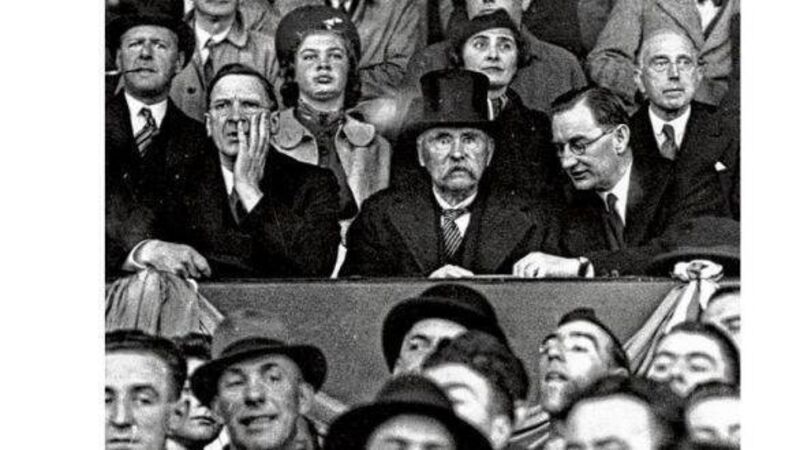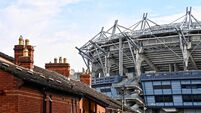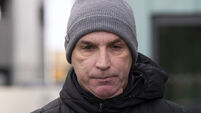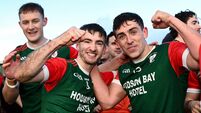Paul Rouse: Why the GAA brought in The Ban - and how TV helped end it

COME ON YOU BOYS IN GREEN: Éamon de Valera, Douglas Hyde and Oscar Traynor watch Ireland defeat Poland 3-2 in Dalymount Park, Dublin, in 1938.
THE rule in question was the GAA’s ‘Ban on Foreign Games’ and the speaker was, Pat Fanning, the president of the association.
Fanning was addressing the GAA’s annual congress which was being held in Queen’s University Belfast on Saturday, April 10, 1971, and in acknowledging that the time had now come for the GAA to remove the ban, he was doing something that he did not wish to do.
Fanning was an ardent supporter of the Ban, but a plebiscite held across the GAA’s clubs through 1970 had left him with no choice. Almost every county in the Association had recorded a vote in favour of removing the rule.
Indeed, so great was support for removal of the ban that there was not even a vote taken on the matter at Congress; there was no last stand from the Ban’s most fervent advocates.
In the context of what had passed before, the end was essentially anti-climactic. For decades, the Ban rules had been bitterly divisive. This was particularly the case since 1958 when Tom Woulfe, a Kerryman who had helped found the Civil Service GAA Club in Dublin and ultimately became its chairman, began a campaign to remove the rules.
The things that were said in the course of that debate through the 1950s and 1960s were quite extraordinary, not least of which was a claim that if the Ban rules were deleted, the GAA would split in two.
But to understand how such a claim — and others in a similar tone — could be made, the Ban Rules must be placed in a historical context.
The rule that Pat Fanning claimed “epitomised the very spirit of the association” was introduced in the first years of the 20th century as a new generation of officials took over the GAA.
These officials were avowedly nationalistic in their beliefs.
For example, a motion passed at the GAA’s 1901 annual congress, said the GAA was much more than a “mere sporting organisation”, it was instead actually engaged in a “struggle to crush English pastimes” and a “patriotic effort to make young men more thoroughly and essentially Irish and self-respecting.” At the 1903 Annual Convention a motion was passed on the centenary of the death of Robert Emmet, expressing ‘profound admiration of the services and sacrifices of the pure-souled patriot who endeavoured a hundred years ago to overthrow English rule in this country and pledges its adhesion to the manly principles for which he laid down his noble life.’ Beyond words, there was also a practical attempt to promote the GAA in opposition to ‘foreign games’. Barriers were erected between what were presented as the ‘native games’ of the GAA and ‘foreign games’ such as rugby and cricket.
Between 1901 and 1905 the GAA at national level introduced a set of rules which ultimately decreed that anyone who played, promoted or attended ‘foreign games’ (the listed ‘foreign games’ were cricket, hockey, rugby and soccer) could not participate in the GAA.
Later, it was added that anyone who was a member of the police or the British army was prohibited from membership of the GAA.
Further, no GAA club was allowed to organise any entertainment at which ‘foreign dances’ were permitted, and any GAA member who attended dances run by either the British security forces, or by ‘foreign games’ clubs, was liable to a suspension of two years.
All of these rules were put in place in the ten years between 1901 and 1911 and were clearly part of a wider resurgence of ideas of an Irish-Ireland extending across language, music, and theatre.
On the surface, the words and actions of the GAA at national level suggest an organization that was radicalising and increasingly extreme in its politics.
To what extent was this a posture of a certain few officials and to what extent did it hold across Ireland?
In certain clubs and in certain counties, the promotion of the GAA as a nationalist organisation was more heavily pursued than in others. Its language was virulently anti-British: soccer players were derided as ’Orange Catholics’ and ‘West Britons’; the game they played was condemned as ‘English’ and, by extension, Protestant.
The fact that soccer supporters fought each other on the terraces and that the soccer authorities did not allow games be played on Sundays was presented as evidence of their ‘alien’ nature.
Secret police reports from the time – increasingly hysterical in tone – noted that “the general tone adopted by the leaders is hatred of England, and games of English origin are decried.” The ambition, it seemed, was to get “hold of the youth of the country and [educate] them in rebellious and seditious ideas, so that when England should get into fresh difficulties, they may have to hand material ripe for a possible rebellion.
But even in areas that were considered in the vanguard of resurgent GAA nationalism, it is clear that there were great limitations to any such ambitions.
ONE such county was Wexford where men such as Seán Etchingham (a columnist on GAA matters for the ), Seán O’Kennedy (the outstanding Ross Geraldines footballer), and the Enniscorthy men Pádraig Kehoe and Frank Boggan, attempted to push the GAA towards a more radical nationalist position.
They promoted Gaelic games but also language revival through the Gaelic League. A local priest, Fr Murphy, told members of the Gaelic League in Enniscorthy that they should be involved with Gaelic games and not with “the games of the foreigner”.
The problem was that around these radicals and zealots, there were a whole range of members who displayed little interest in the Irish cultural revival and whose membership of the GAA was rooted in a desire to play hurling and Gaelic football.
The failure of such members to match their cultural ambitions drove activists such as Kehoe and Etchingham into a state of high dudgeon. When a member of the Enniscorthy-based Volunteer GAA club, Robert Hanlon, looked for re-admission to the GAA having attended a dance run by a rugby club, the case was made by a member of his club that Hanlon understood he was doing nothing wrong:
What! Attended a Rugby dance and he understood he was doing nothing wrong?
What class of a dance is this? Is it like the Tango?
A little above that.
He must come here and express his regret and make an apology.
What is the Association coming to? Here we have a man breaking the rules, and afterwards seeking to be re-admitted.
Already by 1907, the GAA was claiming in an official publication in 1907 that its ban rules had “done more to make the name of the English garrison obnoxious to hundreds of young Irish men than all the speechifying and literature conceivable could possibly effect.” Evidence for this was said to come from Co Cork where it was claimed that not a single soccer ball was kicked outside a British army barracks. This was not accurate, for course, but the opposition to soccer, cricket and rugby continued unrelentingly.
All the while, the rhetoric of opposition to ‘foreign games’ was incessant with those who played ‘foreign games’ derided as shoneens and West Britons and portrayed as being less than fully Irish.
Beyond rhetoric, however, the ambition of drawing a line between Irish-Ireland and West-Britain was no straightforward task. This was seen by the almost annual attempts within the GAA to have those rules weakened or removed.
More than that, the number of GAA men attending rugby matches was acknowledged to be large; Such men were condemned for giving moral and financial support to ‘foreign games’, but the frequency of the condemnations emphasises their impotency.
There were many players who — despite the ban introduced by the GAA — were more than happy to shift from code to code, playing whichever game appealed to them, or was available to them.
This was particularly the case in Limerick — but also beyond that city. As the historian Liam O’Callaghan has written, the presentation of the clash between rugby and the GAA as rooted in two opposing modes of political or cultural beliefs — the ‘Gael’ versus the ‘Shoneen’ — was not grounded in reality.
Rather ‘it can be read as a conflict between two modes of thought: those who saw as imperative the expression of nationality through sport and those who were swayed by personal conviction and social context.’ And there was also a widespread willingness to do business with those whom the GAA was supposed to oppose. As the historian Tom Hunt has noted, the Castlepollard Hurling Club in Westmeath presented a special hurley to the Countess of Longford in 1906 “in consideration of her ladyship’s thoughtfulness to the hurling club in erecting seats for their accommodation as well as leaving a field for their disposal all the year round.” In 1912 Bunclody GAA club passed a vote of thanks to Robert Hall-Dare, the huntsman and British army officer, for the use of a field for Gaelic games.
THE infinite connections and complexities of life in small-town Ireland meant that neat divisions based on sport were not easily achieved. They were rendered still more difficult by sporting ambition as even clubs run by idealistic officials became tangled up in Ban-related controversy, leaving the lingering suspicion that even ideologues were prepared to sacrifice Irish-Ireland in order to win a match.
Back in Enniscorthy, the zealous Pádraig Kehoe was for several years the leading official of the Red Raparees club, yet his club was several times accused of transgressing the ‘Ban’ rules. The Red Rapparees’ victory in the 1909 county final was objected to on the grounds that two Rapparees players were members of the British Army.
Then, in 1912, after the Red Rapparees won another final, it was claimed that a member of the winning team, James Quinn, was also a British soldier.
At a meeting to discuss the matter, Frank Boggan, as chairman of Wexford County Board, said that Quinn had indeed joined the army when he was 15 or 16 years old and had now been bought out. The objection was defeated, yet Quinn’s census return shows that he remained a reservist in the British Army.
After the establishment of the Irish Free State and the partition of the island, the great area of contention in the GAA’s nationalism came from ‘the ban’ rules.
There were a series of debates in the 1920s as to whether the rule should be deleted. These debates were shrill, but the rule was never in serious danger of being repealed. Those GAA members who argued that the war was over were smothered in the rhetoric of those who said that Ireland’s martyrs had not died so that its people could play soccer or rugby. The guns may have become silent, but there was still a revolution to be won.
And the result of the rhetoric was to actually strengthen the ban. Vigilance Committees were established to attend ‘foreign games’ matches and to report if any GAA members attended, and GAA clubs were banned from holding any entertainments at which ‘foreign dances’ were undertaken.
For all that there was an idealism that underpinned these rules, they were capable of exposing the GAA to popular ridicule: in 1938 the first president of Ireland, Douglas Hyde, (chosen in light of the passage of the 1937 constitution) attended an international soccer match in Dublin in the course of the duties of his office.
As well as being the President of Ireland, Hyde was celebrated as a founding father of modern Ireland; he was a distinguished Gaelic scholar and the intellectual driving-force behind the founding of the Gaelic League.
He had been friends with Michael Cusack, the GAA’s founder, whom he had come to know in Irish language circles in Dublin in the 1880s.
As long ago as 1892 Hyde had written that the progress of the GAA had ‘filled him with more hope for the future of Ireland than everything else put together.’ Time and again Hyde had lauded the GAA for its ‘brave and patriotic’ work in rejuvenating Ireland. In return, the GAA had made Hyde one of its patrons in 1902.
Now, though, in 1938, as Cormac Moore has written, his attendance at a soccer international between Ireland and Poland (accompanied by Éamon de Valera) was raised at a Central Council meeting of the GAA.
In response, the president of the GAA, Pádraig MacNamee, ruled that because of Hyde’s actions, he had “ceased to be a patron of the Association”.
In the public uproar that followed the GAA was widely castigated for its decision. Later in 1938, Pádraig MacNamee – known around GAA circles as a principled and decent man who devoted his life to service of the Association – set out the ethos that underpinned the decision. In the process he offered a clear vision of what he considered the GAA stood for: “The critics tell of a wonderful thing called ‘internationalism’. The people who talk of internationalism really mean Anglicism. They describe English games as international; they pander deliberately or unwittingly to England’s superiority complex. They talk of ‘bans’. Even English critics admit the superiority of hurling as a field game, but I wonder how many English colleges have introduced it as part of their athletic curriculum. On one point I agree with our critics, and that is when they say that we are intolerant. My only complaint is that we are not half intolerant enough. We and all Irishmen who value the inheritance of the Gael must always be intolerant of everything foreign in this country. We can never rest until the last vestige of foreign dominion is gone beyond recall. I dream of the day when a Gaelic Front will come into existence – a Front consisting of a union of organizations, each looking after its own particular part of the Gaelic revival, and all united in the ultimate aim — ‘A Gaelic Ireland.’ But, all the while, the Ban was widely defied — indeed, it was claimed repeatedly that it was something “more honoured in the breach than the observance”.
For example, in the summer of 1955, the annual cricket match between teams representing the married and single men of the Bank of Ireland was played in the grounds of the Pembroke Cricket Club. One of the stars of the show was a “star of the GAA’” who was credited with some “lusty batting”. The Irish Banking Magazine teasingly gave his name as ‘Dxn Bxcxlxy’, presumably to ensure he was not the subject of ban-related controversy.
It was later that decade that Tom Woulfe began his campaign to remove the ban rules. Much of Woulfe’s personal motivation behind the ban campaign stemmed from 1948 when he had acted on behalf of a Dublin County Board Vigilance Committee. He reported on a member who was suspected of playing ‘foreign games’. That player was suspended and never returned to the GAA.
Woulfe was filled with disgust at the incident and later, when he became chairman of the Civil Service Club, he brought a motion to the GAA to have the rule abolished. Woulfe’s attempts failed in 1962, 1965 and 1968 (the matter could be debated only every three years), until in that latter year it was agreed that a committee would actually be established to examine reasons why the rule was important.
Following on from that, it was agreed that every club in Ireland should hold a meeting to discuss the report that was produced by that committee. That report — from a committee stuffed with ban supporters — was absolute in its advocacy of keeping the rule.
But during 1970 and early 1971, when the matter was debated by the clubs, in county after county the great majority of clubs voted to remove the ban.
THE changing nature of modern society was essential to what happened. The great agent of social change in the modern world was television. By 1961, 85% of homes in America had television sets, with a slightly lower percentage in Britain where 10 million homes had TVs. The spread of television in Northern Ireland was exemplified by the launch of BBC Northern Ireland in 1953 and this was followed in 1959 by the launch of Ulster Television.
The lure of television was such that within two years of the opening of the Republic of Ireland’s national broadcaster, Teilifís Éireann on New Year’s Eve, 1961, 44% of Irish homes had a television; by the end of the decade television were installed in 76% of all homes.
Television changed so much about Ireland and this change is readily apparent in the manner in which it reshaped the Irish sporting world.
Initially, only the All-Ireland football and hurling semi-finals and finals, as well as rugby and soccer internationals and the FAI cup final were shown. To that was added limited coverage of horseracing, boxing, athletics and sundry other sports. It allowed for people to see sports that had never been previously available to them.
When the 1966 World Cup, held in England, was broadcast on Irish television, a general growth in interest in soccer was noted in the Irish press.
It was too much for one GAA columnist, ‘An Fear Ciúin’, who wrote in that the World Cup was having ‘disturbing effects here amongst those followers who contaminate their minds with such world-disturbing, unnatural and degrading recreations. Every effort will be made to preserve our Gaelic people from falling into boisterous belligerency..’ But because of television, ‘An Fear Ciúin’ became a man increasingly out of step with his times. The problem was that no amount of contortions could disguise the ridiculous position that one could be banned for going to Lansdowne Road or Dalymount Park to watch a match, but not banned for sitting at home and watching on TV.
The supporters of the Ban said the rule continued to promote the idea of an Irish-Ireland and was forcing Irish people to choose between being Irish and being a West-Briton.
But the opponents simply pointed out that a man was no less of an Irishman because he played rugby or soccer. They noted that the likes of Kevin Barry and Éamon de Valera had been rugby players.
The world was changing around the GAA’s traditionalists, however; the sands of time could not be held back indefinitely.
When Pat Fanning made his speech in Belfast in 1971, he acknowledged that the ‘foreign games’ rule would be deleted. But this is not precisely what happened.
In the context of the first years of the ‘Troubles’, with the Congress being held in Belfast, the ban on members of the British security forces being members of the GAA was held in place.
More than that, in the course of his speech, Fanning set out a certain rearguard action. He asked: “Are our clubs, their roots deep in parish, town and city to cease to be GAA units as our fathers moulded them? Is it possible our Gaelic fields, purchased and developed with GAA money so that Irish boys should play Irish games, may be used for other purposes to weaken and perhaps ultimately destroy the association?”
This question led to a new rule — Rule 42, on the playing of non-Gaelic games on GAA pitches — being introduced into the GAA’s official guide. In time, this rule too became the focus of great and repeated controversy.








